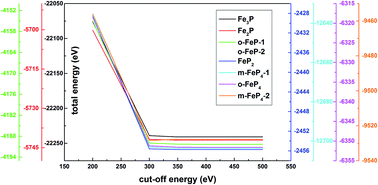Structure, stability, mechanical and electronic properties of Fe–P binary compounds by first-principles calculations
Abstract
The equilibrium crystal structures, stability, elastic properties, hardness and electronic structures of Fe–P binary compounds (Fe3P, Fe2P, o-FeP-1, o-FeP-2, FeP2, m-FeP4-1, o-FeP4, m-FeP4-2) are investigated systematically by first principles calculations. The calculated formation enthalpy is used to estimate the stability of the Fe–P binary compounds. Fe3P has the largest formation enthalpy at −44.950 kJ mol−1 and o-FeP-2 has the smallest at −78.590 kJ mol−1. The elastic constants are calculated by the stress–strain method and the Voigt–Reuss–Hill approximation is used to estimate the elastic moduli. The mechanical anisotropy of FexPy compounds are studied using the anisotropic indexes and by plotting the 3D surface contour of Young’s modulus. The electronic structures and chemical bonding characteristics of the Fe–P binary compounds are interpreted by the band structures and density of states. Finally, the sound velocity and Debye temperatures of the Fe–P binary compounds are discussed.


 Please wait while we load your content...
Please wait while we load your content...